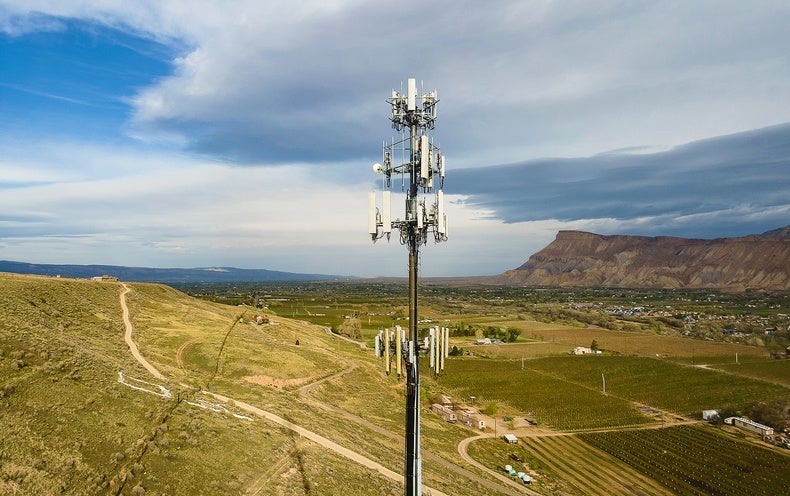High-speed Internet access has become crucial in a world where school, business, personal life and emergency communications increasingly take place through a handheld device. But surprisingly large swaths of the U.S. still lack a speedy-enough broadband or cellular connection. One potential solution could be a sixth-generation cellular network, which experts say will add a space-based system to ground-based coverage options. This 6G network could eventually connect the entire nation to high-speed data—but its development is still in the early stages.
Activities such as attending video meetings and streaming high-definition video can require download speeds of 25 megabits per second. But in 2019 those speeds were out of reach for 4.4 percent of Americans, according to the most recent Broadband Progress Report from the Federal Communications Commission. That lack of access to reliable Internet is roughly four to five times higher in rural communities (17 percent) and on tribal land (21 percent), respectively, contributing to a digital divide that disproportionately impacts already underserved communities.
This summer the federal government took steps to boost connectivity by expanding existing broadband infrastructure. In late June the Biden administration announced a $42.45 billion commitment to the Broadband Equity, Access, and Deployment (BEAD) program, a federal initiative to provide all U.S. residents with reliable high-speed Internet access. The project emphasizes broadband connectivity, but some researchers suggest a more powerful cellular connection could eventually sidestep the need for wired Internet.
The 6G network is so early in its development that it is still not even clear how fast that network will be. Each new generation of wireless technology is defined by the United Nations’ International Telecommunication Union (ITU) as having a specific range of upload and download speeds. These standards have not yet been set for 6G—the ITU will likely do so late next year—but industry experts are expecting it to be anywhere from 10 to 1,000 times faster than current 5G networks. It will achieve this by using higher-frequency radio waves than its predecessors. This will provide a faster connection with fewer network delays.
No matter how fast the new network turns out to be, it could enable futuristic technology, according to Lingjia Liu, a leading 6G researcher and a professor of electrical and computer engineering at Virginia Tech. “Wi-Fi provides good service, but 6G is being designed to provide even better service than your home router, especially in the latency department, to address the growing remote workforce,” Liu says. This would likely result in a wave of new applications that have been unfathomable at current network speeds. For example, your phone could serve as a router, self-driving cars may be able to communicate with one another almost instantaneously, and mobile devices might become completely hands-free. “The speed of 6G will enable applications that we may not even imagine today. The goal for the industry is to have the global coverage and support ready for those applications when they come,” Liu says.
Although 6G’s theoretical speeds sound exciting, the 5G network that preceded it also claimed to offer a blazing-fast connection. But people in many parts of the world still lack access to 5G infrastructure; even devices designed to take advantage of 5G must include the ability to fall back on 4G and 3G connections if and when those slower networks are the only available options. “The coverage of the 5G cellular network is only about 10 percent of the Earth’s surface right now,” says Jeffrey Andrews, director of 6G@UT, a research center at the University of Texas at Austin that works on underlying technologies to support 6G cellular networks in the near future. That coverage area could dramatically change in the 6G era, Andrews says, because the new generation will be partially based in space, enabling it to cover much more of the planet than its ground-based predecessors. “I think utilizing space systems to provide global coverage will be a revolutionary aspect of the 6G era,” Andrews says.
Current 6G research-and-development efforts are focused on creating nonterrestrial networks made up of low-Earth orbit (LEO) satellites and uncrewed aerial vehicles. These networks are expected to operate at a fraction of the cost of 5G, which relies mainly on ground-based fiber-optic cables and cellular towers. According to Andrews, piggybacking off the LEO constellations that are already in the works will enable 6G to offer a cheaper connection than 5G, which requires time and money to install fiber all over the country, including in places with relatively few inhabitants.
Those sparsely populated areas are a major target of the BEAD program—so if BEAD connects the entire country to existing broadband networks, will 6G global coverage even be necessary? Although the BEAD investment is a step toward bridging the digital divide, some experts question its potential. BEAD allocates funds to each U.S. state and territory based on the FCC’s broadband map, which has faced scrutiny from the telecommunications industry because of various inaccuracies. One earlier version of the map was challenged in more than four million locations.
“I cannot understate that the way that data decisions were made in the creation of this map will have ramifications for generations,” says Alexis Schrubbe, director of the Internet Equity Initiative at the University of Chicago’s Data Science Institute. “This map is probably the highest-stakes data product that the federal government has ever created.” This makes its flaws extremely consequential. According to Schrubbe, the algorithms used to identify broadband serviceable locations for this map often made mistakes when analyzing Native American land and rural areas—prime examples of the very locations where more connectivity is so badly needed.
Even as the FCC continues to develop its broadband map for a better understanding of where coverage needs lie, the map’s problems mean that 6G may eventually be able to connect every device in the U.S. more quickly and cheaply. Schrubbe views the two types of technology as complementary. “They work in concert with each other,” she says. “It’s not necessarily that one is competing with the other—rather, that if we have a better-distributed transport system across the United States, it will open up avenues for those technologies to blossom even more.”
Another way 6G will improve on previous generations is the way it uses artificial intelligence, says Harish Viswanathan, head of radio systems research at Nokia Bell Labs. “I think we will see a lot of applications of AI in 6G, much more than what we are aiming to do in 5G,” Viswanathan predicts. AI will help existing networks conserve energy by analyzing data usage in real time, as well as playing a crucial role in how fast data can be processed and uploaded. “Machine learning, in particular deep learning, which we call artificial intelligence, has made significant advances in other domains,” Viswanathan says. “Those tools are now relevant to us in wireless communications.”
Sixth-generation communication technology may offer revolutionary promises, but it won’t replace existing networks for some time: earlier this year, the ITU estimated that 6G won’t become available to consumers until 2030.




